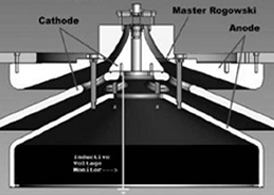
The COBRA pulsed power generator is a low-impedance 0.5 ohm pulse generator for high energy density (HED) plasma research. COBRA was designed to drive loads of order 10 nH to a nominal 1 MA. The design allows the operator to choose among a variety of current waveforms with zero-to-peak rise times in the range of 95–230 ns, and full width at half maximum of ~300 ns. Since COBRA is intended for a variety of different HED experiments such as gas-puff z-pinches, wire-array Z pinches, X pinches, and conical wire arrays for jet production, and is available to external as well as internal users, this pulse shape flexibility is an important and unique feature.
The diagnostic set on COBRA includes a 10 J Thomson Scattering diagnostic for electron and ion temperature and plasma flow velocity measurements, multiple interferometry channels for plasma density measurements, gated visible light and extreme ultraviolet multi-frame cameras, a visible light streak camera, several visible light spectrometers, a time-integrated soft X-ray spectrometer, time-resolved X-ray instrumentation, and others. The necessary digital data acquisition systems for all of these diagnostics are also available.
The primary application of COBRA is to drive wire array Z pinches. To facilitate use of these loads, the final vacuum power feed, and the load are oriented with a vertical axis. A clear diagnostic line of sight is preserved through the vertical axis, and the pulsed power is also configured to leave the equatorial (horizontal) plane unencumbered to allow maximum diagnostic access and easy experimenter access to the load vacuum chamber.
The generator is composed of four identical coaxial water dielectric pulse-forming lines (PFLs) 1.8 ohm, 30 ns long). The primary energy storage is a pair of 16×1.35 μF Marx generators charged to 70 kV. Each Marx charges a water dielectric, 46 nF intermediate storage capacitor. Each intermediate storage capacitor is switched out at about 800 ns for maximum forward energy transfer through a self-breaking sas switch (referred to as the “main” switch). Each intermediate store then charges a pair of the PFLs in 300 ns. Adjustment of the two main switch pressures can be used to synchronize or to intentionally offset the initiation of charging of the two pairs of PFLs. The four PFLs are independently switched into a current adder section by four laser triggered gas switches. To reduce prepulse load voltage to a very low level, these four output switches are oil-insulated to reduce shunt capacitance.

The current adder section is a triplate transmission line in water, with an optimized capacitance to peak the rate of rise of current. This peaking capacitance is required as a result of the relatively high inductance of the output gas switches. The four output switches are connected at symmetric points around the circumference of this circular adder line. The triplate passes radially through a six-ring (Rexolite) 45° graded interface into vacuum, and uses a vacuum post hole convolute to make the transition to the final coaxial feed to the load. The figure below shows the connection of the output switches to the triplate and the vacuum interface.

The vacuum section inside the interface, with the triplate, the convolute, and the final coaxial power feed to the load.

The COBRA configuration, based on the addition of four independently switched current sources, allows considerable variation in the load current pulse shape. The four output switches are triggered by dividing a 5 ns, 100 mJ pulse of 266 nm light from a quadrupled Nd:Yttrium aluminum garnet laser into four beams, and choosing relative optical delays to the four switches to give the desired timing. The switches are adapted from a standard “Rimfire” multichannel switch design3 developed at Sandia National Laboratories. The triggering laser beam enters the switch axially . With this laser, the COBRA switches can be triggered at 80% or more of self-break voltage with closure time of 18–22 ns. At 70% of self-break voltage, closure time is 24–30 ns. Triggering is successful down to about 60% of self-break but with longer and more variable closure times, and below 60% it is unreliable. These output switches can also be operated without the laser in a self-breaking mode with reduced flexibility in the pulse shape.